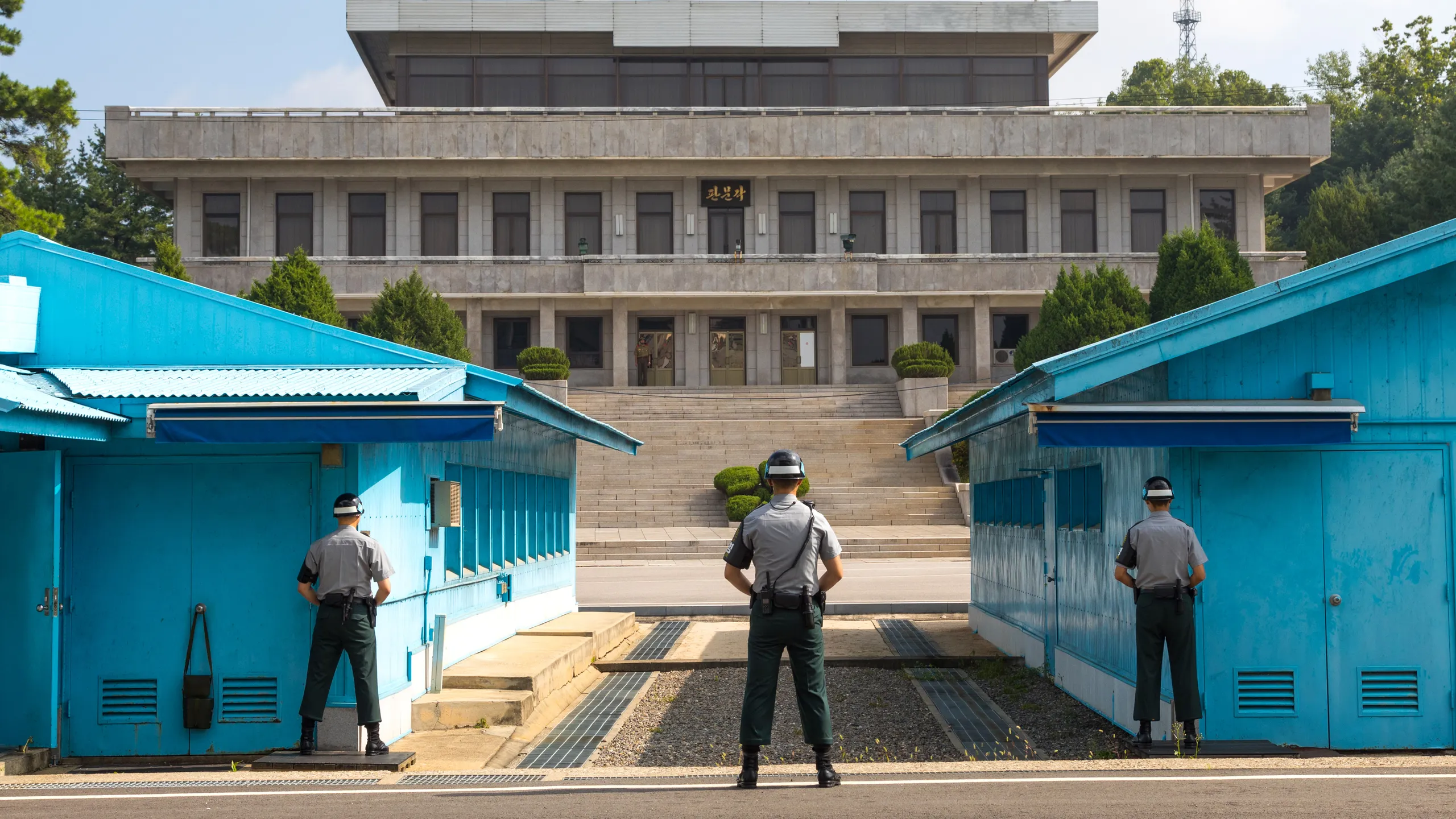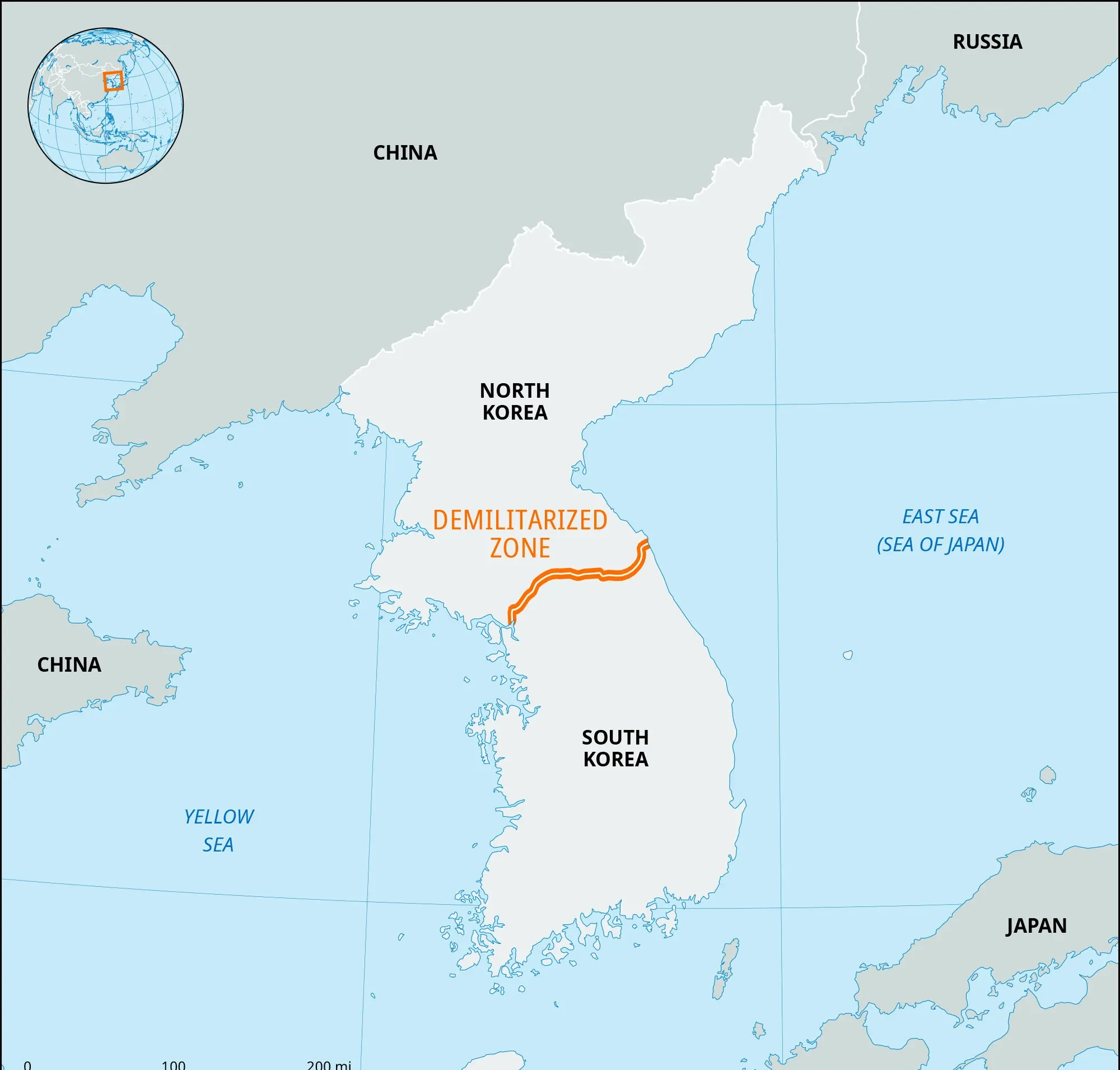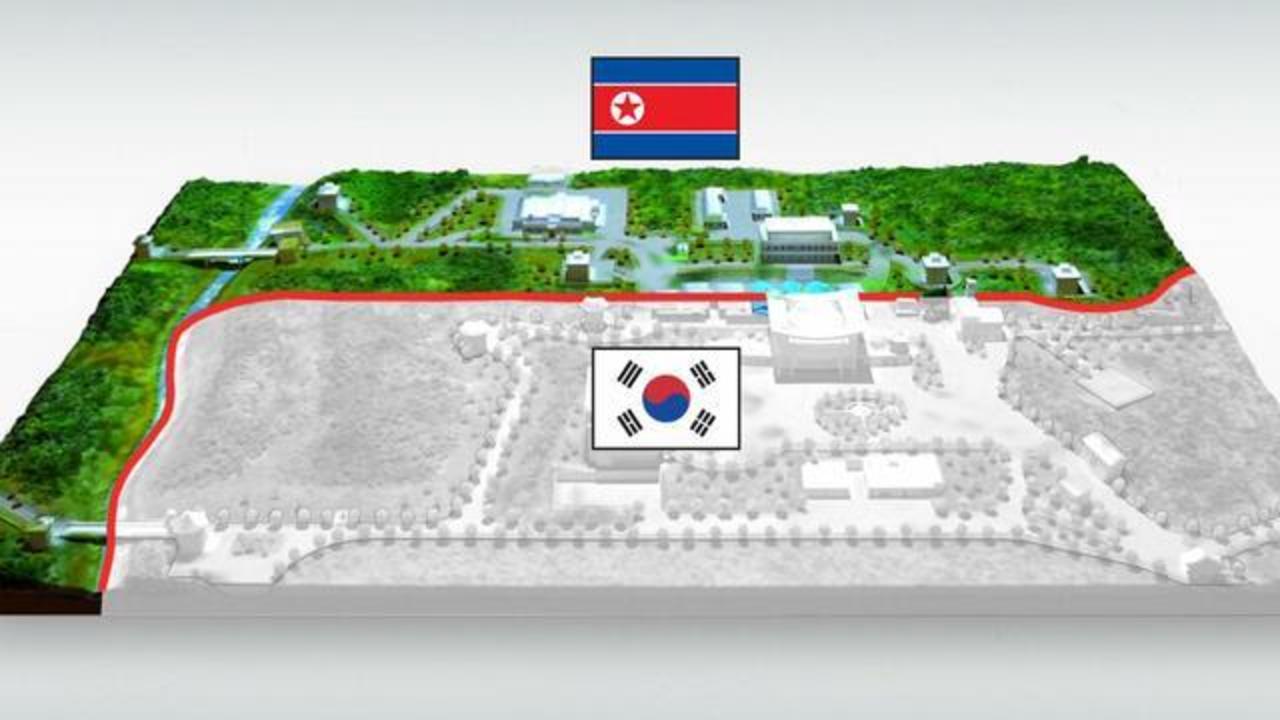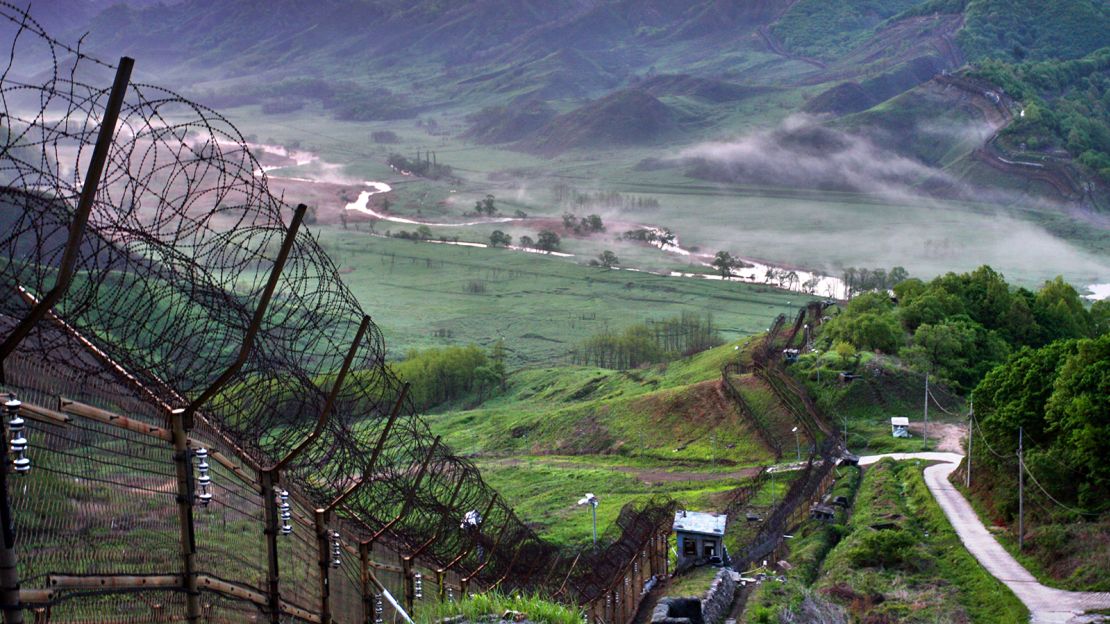Now that we entered what is one of the most unique and probably also in a way slightly disturbing slices of the world: please welcome to the Demilitarized Zone (DMZ). Running across the map from east to west, it comprises a demilitarised strip of land which half-circles the northern edge of North Korea. Cross the border into the DMZ, and you’ll feel as if time has stopped in this surreal landscape.
A land where rolling green pastures almost hide the memories of a divided land. Nature has started to take back what was stolen while barbed wire fences and checkpoint soldiers keep watch. Deeper than the physical perimeter, the DMZ is a representation of Hope, Doubt and Possibility for Peace amongst two enemy nations. As a reminder of the political and military tensions that has (sic) become a defining feature of the Korean Peninsula for decades.
What Is a Demilitarized Zone (DMZ)?
A Demilitarized Zone (DMZ) is defined as an area in which military operations are not permitted, generally used in maintaining neutrality between belligerent forces or nations. The Korean Peninsula, for example, there exists the gengtoto Demilitarized Zone which is an actual physical distance between the North and South Koreas that is roughly 160 miles long by 2.5 miles wide.
It is home to one of the most heavily fortified boundaries in the world and serves as an ongoing reminder of the deep divides that have existed in this region for generations. The demilitarized zone is more than just a line in the dirt, it’s a symbol of the geopolitical and military crosscurrents swirling through the peninsula.
They are implemented to avoid military confrontation and keep the peace between two states with conflict, as well as increase a sense of security for both sides. The objective of a DMZ is to serve as a neutral buffer zone between two hostile sectors that can prevent direct hostilities and facilitate diplomatic negotiations, reducing the (accidental) escalation effect of bloody conflicts and eventually enhance regional or international security and stability.
While it is called a Demilitarized Zone, the area does in fact contain military installations, minefields, guard posts and surveillance measures to monitor activity along the border.

What Is a DMZ for?
A DMZ is a buffer zone, or an area that nobody claims at full: Website Mai -Hostingu PLEASE. Creating a containment zone where you are not allowed to conduct military operations would hence keep both sides somewhat safe in their own right without actually bombing each other. The theoretical weight of a Demilitarized Zone is that it provides symbolic and material ground between one state and the next for communication, diplomacy, negotiation, cease-fire or even truce.
In the case of the Korean DMZ, it symbolizes this iron curtain between two countries in common history and inclemently divided ideals. The DMZ, a region that is teeming with tensions, also offers the possibility for reconciliation and peace talks.
A DMZ is, of course, a diplomatic and political agreement that signals to other states not preparing in kind that your state neither seeks nor desires war. It reminds us all of the necessity of peaceful human coexistence, whilst also serving as a framework for conflicting sides to engage in dialogue. Setting up a Demilitarized Zone requires participation of both parties, along with adhering to certain protocols so each side respects the boundaries and purposes laid out by the demilitarized zone. Even if the specifics of a DMZ are adaptable and situational, at its very essence the aim of one is always the same: to deter conflict, preserve peace, and open up paths for negotiation.
Components of a DMZ
In its simplest form a DMZ tends to be made up of several different but interconnected components that meet the bigger picture of creating a secure, controlled buffer zone between 2 conflicting factions. These components are fenced, walled, and/or mined boundaries that mark the limits of the Demilitarized Zone and generally prevent illegal entry.
The DMZ on both sides has military installations and checkpoints in which the security operates to observe the activities of citizens living near by, scout any possible agents that may enter from one part at the other, or to respond efficiently if something as bad happens. This is contradictory to surveillance technology, like cameras, sensors, drones which are used for increased border control and intelligence gathering.
It may include physical infrastructure and a DMZ (demilitarized zone) between the borders of the two entities, and mechanisms for managing communication protocols – then through logical data exchange or conduit that does not pass over, but goes through the Demilitarized Zone providing hardening also with such barriers as identity-based security and conflict resolution technology built sacrificially at reduced scope to passivate dialogic approach in contrast to another response-oriented approach.
These elements are crucial in order to safeguard the impartiality of the DMZ and ensure a common ground for dialogues at difficulty. A Demilitarized Zone, through the combination of military deterrence with diplomatic initiatives, seeks to both secure against threats while providing avenues for dialogue and cooperation in the interest of conflict management and resolution.
Advantages of using a Demilitarized Zone
The establishment of a DMZ provides several potential advantages for countries involved in internecine political or military conflicts, by offering a logical organization of territorial units that can help emerging dialogues and decrease conflict dynamics. DMZs enforce a buffer zone where certain military activities are prohibited, allowing for confidence-building measures that reduce the risk of accidental confrontation, miscalculation, or escalation to broader conflict.
By incorporating proactive security, it allows for nurturing trust, disclosing honesty and avoidance of possible misunderstandings among conflicting parties.
In addition, as confidence-building measures, a Demilitarized Zone demonstrate a willingness to peaceful, stable and diplomatically engaged. When establishing rules to govern behavior on the global stage, nations can demonstrate a commitment to the rule of law and respecting international norms, all while working towards resolving tense situations peacefully. It can also be use as a meeting place, to co-operate in trade, aid, and the environment. Such is the contenct of this statement: the DMZ (de-militarized zone) has benefits that reach far beyond mere military definitions to include legal, political and economic dimensions.

Understanding Demilitarized Zones misconceptions
While DMZs are important for conflict management and security, they are often mischaracterised in discussions. Another common misnomer is a notion that the DMZ is unclaimed territory with no military in sight. The DMZ also contains numerous military installations, surveillance equipment and personnel to monitor activities at the border and respond to potential threats. Thought the level of militarization may differ, a DMZ is ultimately established as interim border where weapons are prohibited rather than as an entirely neutral or disarmed territory.
A DMZ is not good for anyone as they oppose that both are separate from each other and never come to it in result of divide happen among them. Though some demilitarized zones date back decades, they are not designed to secure animosities but rather reduce tensions and limit conventional warfare. DMZs, are the flexibility and adaptability of DMZs as it responds to changed political dynamics, then to peace negotiations, security conditions and their transformation over time. Demystifying these and grasping the finer points of what DMZs actually do, allows us to begin to understand why they are vital for maintaining peace and stability in some of the worlds most unstable places.
How to set up a Demilitarized Zone
To make sure a DMZ works as designed to create a buffer zone, you must follow standards and an effective strategy to implement it correctly. It will start with an agreement between the conflicting parties on defining the DMZ boundaries; considering, over geographic, political and security issues. These physical barriers, which are often rows of fences or walls tens of kilometers in length and marked by checkpoints, are designed to obstruct the northern side from crossing and claim a buffer zone.
This is followed by various military installations along with surveillance equipment and communications facilities that allow monitoring of the border, response to potential cross-border security threats and easing coordination between the opposing side. The DMZ sets rules of engagement, communication and de-escalation guidelines defining how parties agree to interact in order to avoid misunderstandings or progressing into a higher potential for conflict. Patrols, checks or joint exercises are also prohibited to maintain the Demilitarized Zone as a neutral place of engagement and dialogue.
Issues in Security for a DMZ
To keep DMZ working as a buffer zone and avoid security incidents resulting in war, maintaining proper security is the most important factor. Fences, walls or minefields can also be added on the boundaries of the DMZ area to make sure no one crosses them without permission. Surveillance technology, such as cameras and sensors, along with drones to increase monitoring capabilities and real-time intelligence at the border.
Besides of physical security, cybersecurity related measures are mandatory to prevent the compromise of a DMZ, like any potential threat from outside or within the network. All network connections and data transmissions in the Demilitarized Zone are secured using firewalls, intrusion detection systems, and encryption technologies to mitigate potential unauthorized access or data breaches. We also recommend regular security audits and vulnerability assessments, as well as incident response plans to identify and respond to potential risks to the infrastructure and operations of the DMZ.
DMZ best practices
To be used as an implement which zone serves the buffer and encourage peace and stability, the best practice in DMZ systems should be practiced on it planning, designing, creation and management. In order to ensure misunderstandings are kept at bay, the DMZ has been designed to promote trust and ease of communication between opposing parties. This is achieved through continual dialog, combined exercises and confidence-building measures which can help to take the extreme edge off of inherently adversarial relationships.
The operation of a DMZ, with transparency and accountability in mind, should help guide the respect amongst all stakeholders to engage manner that are consistent to agreed protocols and objectives. The DMZ might face particular violations through CONDUC or security incidents, violation if DDA mechanism is in functioning and need to identify by monitoring (monitoring mechanisms ASSISTED/ASSISTANCE).
The URCCB and MODC are responsible for oversight at both the country officer and field -level. The promotion of these best practices is what can turn a DMZ into a positive tool for conflict management, peacebuilding and regional cooperation.

Successful DMZ Deployments
There is no shortage of examples from around the world of DMZs serving as successful tools for conflict management and peacebuilding. For example, the Korean Demilitarized Zone is perhaps the most iconic social-ecological fence in the world and serves as a poignant (however fraught) symbol of possibility for future reunification on the divided peninsular.
One of the most famous is the meeting place of Panmunjeom that has facilitated diplomatic and confidence-building measures and cultural exchanges but also reveals a possibility by symbolizing what such DMZs could have contributed within dialogues and cooperation.
The Cyprus Buffer Zone, for instance, was created in 1974 to divide areas claimed by both Greek Cypriots and Turkish Cypriots after fighting between the communities. Although it started out as a temporary solution, over the years this buffer zone has become nearly synonymous with coexistence and cooperation between Greeks and Turks, enabling peace talks, humanitarian acitivities and cultural exchange.
These case studies demonstrate the versatility of DMZs in peacebuilding as well as their utility in post-conflict reconciliation and stabilisation efforts, reaffirming why they are essential tools for peace and security.
Why DMZ is critical to network security
Summary: More than a physical barrier, the Demilitarized Zone (DMZ) speaks to the nuance of war, politics and the quest for peace. A DMZ creates a calm and slow, state of interaction that allows discussion, conversation and the resolution of conflict while lessening risk of military violence thus increasing possibilities for common ground.
Mismatch between the expectations and comments made by those advocating for DMZs aside, the potential of DMZ and peace parks as resources for conflict management and peacebuilding is motivated. If you like reading this article then please consider reading our article about Labuan Bajo.

